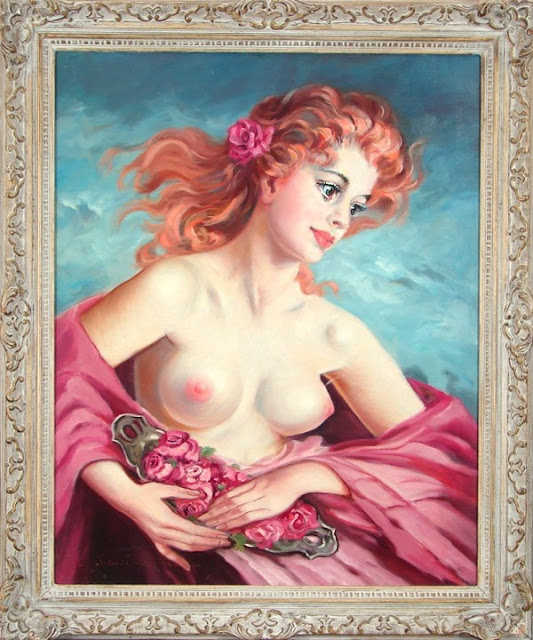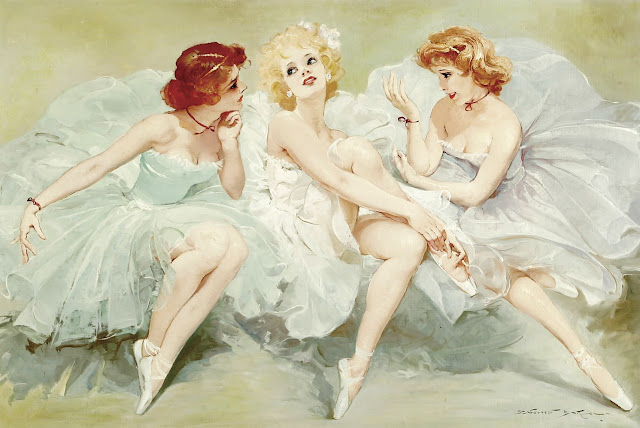MARIA SZANTHO (1897-1997
Maria Szantho (Szeged, July 31, 1897 - Nagymagocs, March 11, 1998) was a Hungarian artist. She exhibited from the mid 1920’s at major art galleries such as the Mûcsarnok in Budapest. She had a collected exhibition in Budapest in 1936. Her work is timeless. She specialised in portraying women posing nude against a landscape, also still lives and portraits. Her models are hedonistically portrayed, she used elements of impressionism and romance.
Maria Szantho was born on July 31, 1897 in the city of Szeged which is in the south part of Hungary. She was born with a caul. According to the Hungarian tradition anyone born with a caul will have a lucky life. Indeed, she had an extraordinary life, gifted in arts, and achieved fame and international appreciation and honour. Her paintings are well known at the best galleries and auction houses, and are valued parts of any collection.
Her full name with correct Hungarian spelling is “bácsai Szánthó Mária”. The forename “bácsai” should be written with lower case ‘b’ as this part of the name is a title of nobility.
She married three times. All three of her husbands passed away and she never had any children. Her third husband was Dr. Ferenc Klauschek, hence some sources mention her as Klauschek Ferencné (“né” is the equivalent of Mrs. in Hungarian). She signed all her paintings with her maiden name.
Szantho Maria’s first love was music, she was a talented piano player and finished her music studies as a teacher. She earned her Diploma at the Hungarian Music Academy on piano faculty. Her Diploma was signed by Zoltán Kodály the famous Hungarian composer.
Shortly after completing her music studies she had decided to pursue her interest in painting. Went on several study tours to France and Italy, I recall her talking about the Parisienne atmosphere . Her rich and detailed naturalist paintings were inspired by the hedonism of Károly Lotz and the joie de vivre of Gyula Benczúr. She studied with and from famous Hungarian painters such as Géza Kukán, Bertalan Karlovszky, Pál Fried and Mátyás Vitéz.
Maria Szantho exhibited from the mid 1920’s at major art galleries such as the Műcsarnok in Budapest. She had a collected exhibition in Budapest in 1936. Her work is timeless. She specialized in portraying women posing nude against a landscape, also still lives and portraits. Her models are hedonistically portrayed, she used elements of impressionism and romance. Since her first love was music, her portraits and nudes often permeated with musical themes and idyllic environments enhanced with rich draperies and musical colour accords. Banjo, violin or tambourine were some of the musical instruments she depicted. I recall when I was a child, I often played with these instruments she used to copy on her paintings.
In 1939 she represented Hungary with three paintings on the New York World’s Fair. The paintings sent to the New York World’s Fair have never been returned to her, or to Hungary because of the beginnings of WWII.
Around 1942 she created the historic master piece ‘Legend of the Mythical Stag’ (original title: ‘Rege a csodaszarvasról’). The painting created a lot of press echo and it earned her the prestigious Esterházy Prize. This wall size epic and erotic painting depicted an ancient Hungarian historical scene. Unfortunately it was destroyed in WWII. I recall seeing a photograph of the painting in the 1970s. At the time I was a child spending an afternoon at the painter’s home. I do not remember if the photo was in a book or else, and I have not come across since another photo of this short lived but historical painting. If anyone who has an illustration or photo of this painting are reading this, it would be interesting to hear from them.
In the early 1950's the Embassy of the Soviet Union contacted her and asked her to paint a huge portrait of Stalin. She objected saying that materials are scarce, she did not have access to a large canvas. The Soviets arranged to ship her a huge canvas from Moscow. Stalin passed away unexpectedly in 1953, so she did not have to paint the portrait. They have never asked her to give back the canvas which she put to better use.
Maria Szantho’s main foreign markets were Japan and the United States of America. She also had many private orders from abroad and Hungary. After WWII in the communist Hungary one was not allowed to sell privately to western countries, so she had to use the government owned foreign trading company “Artex” to export her paintings. Some of her then exported and her pre WWII paintings can be found periodically at Christie’s and other fine auction houses.
She is listed in The Bénézit Dictionary of Artists, although with incorrect date of birth and death. In 2008 I contacted an editor at Bénézit regarding the entry, it will be corrected in the next edition.
On her 100th birthday on July 31, 1997 a Minister of the Hungarian Republic greeted her on her birthday party at Nagymágocs, Hungary. On October 23, 1997 she received one of the highest official Hungarian recognitions. Árpád Göncz then President of the Republic of Hungary awarded her with the decoration of the Officer’s Grand Cross of the Hungarian Republic to honour her lifetime achievement.
bácsai Szánthó Mária passed away at the age of 100 and half year on March 11, 1998 in Nagymágocs, Hungary at the Castle Karolyi (Károlyi Kastély). She is buried at the local cemetery together with her brother Dr. Kálmán Szánthó, my grandfather.








































Tidak ada komentar:
Posting Komentar